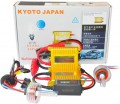Luminous flux produced by a car lamp; for dual-mode models like bi-xenon (see “Type”), the value at maximum brightness is indicated.
This parameter characterizes the actual brightness and efficiency of the lamp; it can be used to directly evaluate and compare different models, regardless of their type and power consumption (but only at the same color temperature - see below for more details). The brightest are headlight lamps (see “Purpose”), in them this indicator can
exceed 4000 lm and vary noticeably from model to model. Therefore, when choosing such a lamp, you should pay special attention to the characteristics of the luminous flux. It should be borne in mind that too bright headlights are just as undesirable as too dim ones: high brightness creates not only the risk of dazzling for oncoming cars, but also discomfort for the driver himself. Optimal luminous flux values can be indicated in the documents for the car or for the headlight itself; if such data is not available, you can turn to other special sources.
As for other types of lamps, in models for auxiliary lighting the luminous flux is up to 800 lm, and in lamps for the instrument panel - up to 55 lm. Moreover, in both cases, the brightness is selected by the manufacturer taking into account the specific specialization and location of the lamp, so in such models this parameter is not a key one.
The maximum continuous lamp operation time. This indicator is quite approximate and the probability that the lamp will work during this period is approximately 1 in 3. This is due to the measurement technique: a control batch of lamps is used until 63.2% of them fail, the resulting time and indicated as "maximum service life". However, the Tc data compared to the B3 guaranteed life (see above) provides a good estimate of the overall lamp life and its ability to last beyond the guaranteed life.

